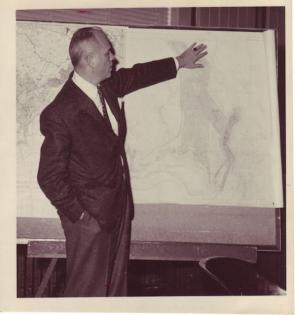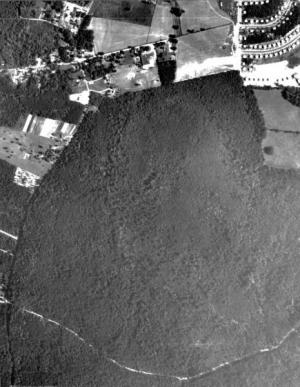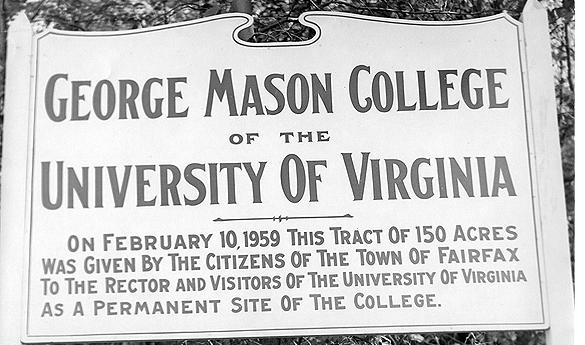The story behind Mason's founding: the college is established
The following piece is the second of a four-part series on the history of George Mason University. The information and research in this article is based off of “George Mason University: A History,” a project created by University Libraries’ Special Collections & Archives department. The first part of the series is available here.
In the late 1940s, a group of Northern Virginia community leaders, lawyers, and politicians began advocating for greater availability of higher education in the region. At the time, the only institution of higher education serving the area’s expanding population was Marymount College, small all-girls’ institution.
After deliberation and planning, the University of Virginia decided to open a facility that would offer vocational classes for older members of the community looking to continue their education. The instantly successful extension center rapidly expanded within a few years. It was not long before community members began discussion on bringing a two-year community college to the area under the administration of UVa.
In February 1956, the Virginia General Assembly passed a one-page bill authorizing UVa to create an official branch college in the Northern Virginia area. Both the UVa Board of Visitors and the citizen-led advisory council were tasked with finalizing a location to house the branch college.
Northern Virginia and U.Va. search for properties to build a college
In the late 1950s, C. Harrison Mann, one of the first advocates and founders of George Mason University, described this era of the institution as one “everyone would prefer not be written. The events to be detailed were very discouraging and depressing, yet…cannot be avoided if the history of how the site, essential to the personality of the institution now occupied by George Mason University, came to be chosen.” At points, university officials debated whether or not the branch college would be established at all.
After the bill was passed, Colgate Darden, then president of UVa, sent recommendations to both the advisory council and the Board of Visitors about where the branch should be located. He requested that the land be no less than 50 acres, have easy access to transportation, and be near major population centers.
The Advisory Council for the Northern Virginia University Center, which successfully established a successful facility in 1949, was comprised of individuals looking to create a branch college close to the population center of the area, which included eastern Fairfax and Arlington.
Deciding on a location would not be simple. The debate involved many parties throughout the state, from local authorities to the governor, and highlighted many of the contentions between Northern Virginia and the rest of the state.
 C. Harrison Mann wrote that many Virginians believed Northern Virginia “...was not like the remainder of the state, that it had become occupied by a large number of outsiders who had nothing in common with the rest of the Commonwealth…the area was inhabited by a bunch of carpetbaggers and radicals.”
C. Harrison Mann wrote that many Virginians believed Northern Virginia “...was not like the remainder of the state, that it had become occupied by a large number of outsiders who had nothing in common with the rest of the Commonwealth…the area was inhabited by a bunch of carpetbaggers and radicals.”
After many months of surveying undeveloped tracts of land throughout the region, the advisory council and the BOV ended up endorsing two different locations.
(Mann presents the Ravensworth property. Photo courtesy of George Mason University.)
The Northern Virginia representatives chose the Ravensworth Farm, a historical site located at the intersection of Braddock road and what is now Interstate 95. The owners of the property offered 50 acres, with an option of purchasing an additional 240.
The BOV protested the Ravensworth site, pointing to plans of constructing an international airport only a few miles down the road in Burke. They were concerned that the takeoff path was directly over the Ravensworth property, and would disrupt the learning environment. Many Northern Virginians, including Mann, said that the Burke location was never a serious candidate to house an airport. Burke was later cast aside as an option for the new airport, and a site further north was chosen for what is now Washington Dulles International Airport.
The BOV, on the other hand, proposed Sunset Hills Farm in western Fairfax, near Herndon. Members of the board believed that they should choose a location that would benefit from greater population growth in the future instead of a location near the population center of the area.
A. Smith Bowman, Jr., a bourbon distiller and owner of the land, offered the university 150 acres, with the option of purchasing additional land in the future.
“Although our location may not today be in the center of the population of Fairfax and Arlington Counties,” Bowman wrote to the advisory council in May 1956. “We believe that in the near future it will be nearer the center of population of Northern Virginia than certain other locations that we understand are under consideration.”
In an October 6 letter to members of the BOV, Mann wrote that the location “is located far from the center of population of the urban area, completely to one side of the area to be served, and is so far removed that students from the populous areas cannot conveniently attend it on a commuting daytime basis. (It was never intended that this branch would serve Loudoun, Clarke, Frederick, Fauquier, except on an extension basis).”
The Board of Control steps in
At this time, another committee established by the General Assembly shortly after the branch college was approved, stepped in to take control of the situation. The Board of Control for the Establishment of a Branch College in Northern Virginia was comprised of many of the same members who made up the advisory council. At the end of 1956, the board took over the site selection duties endowed to the advisory council. The board began publicly requesting applications rather than relying on personal connections to land owners.
In early 1957, the Ravensworth and Sunset Hills properties remained the front-runners. The Alexandria representatives on the Board of Controls told the other members that if the Sunset Hills site were chosen, they would remove their participation from establishing the college, citing that the location was simply too far for their constituents to benefit.
In a letter dated Jan. 13, 1958, President Darden implored Mann to accept the Sunset Hills site.
“It is not so conveniently located as is the site on Route 50 but, with the support of the localities to be served, I am reasonably sure we can make a success of the college if it is placed there, and certainly it would seem to be wiser to have it there rather than abandon it,” wrote Darden.
With the final vote by the Board of Visitors on Feb. 1, 1958, different groups were making a last ditch effort to find a location to better serve the Northern Virginian population than Sunset Hills.
 On a Sunday in Jan. 1958, John C. Wood, mayor of the Town of Fairfax, called a special town council meeting to make an offer for the site of the college. Wood, a real-estate lawyer who represented the owners of the Ravensworth property, had an acute awareness of the difficulties surrounding the debate. At the special town council meeting, he proposed offering 150 acres of property on a tract of land just south of the Town of Fairfax. The council unanimously voted to purchase the land, which was owned by a retired attorney for the Commonwealth of Virginia, Wilson M. Farr, and made a formal offer to the Board of the Control.
On a Sunday in Jan. 1958, John C. Wood, mayor of the Town of Fairfax, called a special town council meeting to make an offer for the site of the college. Wood, a real-estate lawyer who represented the owners of the Ravensworth property, had an acute awareness of the difficulties surrounding the debate. At the special town council meeting, he proposed offering 150 acres of property on a tract of land just south of the Town of Fairfax. The council unanimously voted to purchase the land, which was owned by a retired attorney for the Commonwealth of Virginia, Wilson M. Farr, and made a formal offer to the Board of the Control.
(The Farr property located south of the Town of Fairfax. Photo courtesy of George Mason Univeristy.)
“Of all the tracts suggested to date, the Farr tract is the only one which would satisfy the accessibility requirements of Arlington, Alexandria, Falls Church, Fairfax County, Loudoun County, and Prince William County, and would still conform to everyone’s idea of what a university campus should be,” Wood wrote to Mann in Jan. 1958.
Wood added that the “Farr tract will be undisturbed by airports.”
On Feb. 1, the day of the Board of Visitor’s decision, Mann traveled to Charlottesville to be available for any questions that members might have. Mann was never called upon during the meeting, and the Board voted 9 to 2 in favor of Sunset Hills.
Shortly after hearing about the vote, Mann met with Virginia Governor J. Lindsay Almond, Jr., who had to officially sign off on purchasing Sunset Hills. Mann told Governor Almond that the Northern Virginia municipalities involved in choosing a site were unanimously opposed to building the branch college in western Fairfax. When the Board of Visitors officially petitioned Governor Almond for his approval, he declined citing the dissatisfaction of so many Northern Virginia representatives.
Compromising on the Farr property
Around this time, discussion was rekindled around the Farr property as a viable option. On June 17, Wood sent a letter to Governor Almond alerting him of the land’s availability.
“The site is felt to be equal to or better than any of the ones presently under consideration,” Wood wrote.
The Board of Visitors ultimately accepted the Farr tract, citing its low cost and distance from the Ravensworth property.
In December 1958, the Board of Visitors accepted the Farr tract as the permanent location for a branch college of the University of Virginia, and the current location of George Mason University. In Feb. 1959, the Town of Fairfax sold the land to the University of Virginia for ten dollars.
With the site selected, George Mason College of the University of Virginia would experience growth and challenges after its opening in 1964. The student body and faculty would stage a protest against college leadership, the college would become a four-year institution, and today’s traditions would be set before the university became independent in 1972.
Special thanks to Bob Vay for his assistance for this article. Photos courtesy of George Mason University.
To read more about the history of Mason, visit ahistoryofmason.gmu.edu.

